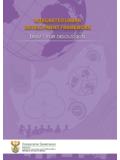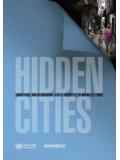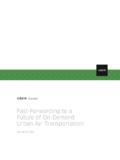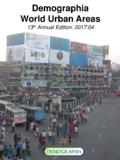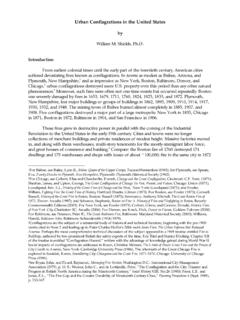Transcription of 22 Benefits of Urban Street Trees by Dan Burden
1 122 Benefits of Urban Street Trees by Dan Burden 222 Benefits of Urban Street Trees by Dan Burden Urban Street Trees 22 Benefits By Dan Burden , Senior Urban DesignerGlatting Jackson and Walkable Communities, Inc; August, 2006 Forest Service facts and figures and new traffic safety studies detail many ur-ban Street tree Benefits . Once seen as highly problematic for many reasons, Street Trees are proving to be a great value to people living, working, shopping, shar-ing, walking and motoring in and through Urban a planting cost of $250-600 (includes first 3 years of maintenance) a single Street tree returns over $90,000 of direct Benefits (not including aesthetic, social and natural) in the lifetime of the tree.
2 Street Trees (generally planted from 4 feet to 8 feet from curbs) provide many Benefits to those streets they occupy. These Trees provide so many Benefits that they should always be considered as an Urban area de-fault Street making new attentions being paid to global warming causes and impacts more is be-coming known about negative environ-mental impacts of treeless Urban streets. We are well on the way to recognizing the need for Urban Street Trees to be preferred Urban design, rather than luxury items tol-erated by traffic engineering and budget conscious city administrators. The many identified problems of Street Trees are overcome with care by designers.
3 Generally Street Trees are placed each 15-30 feet. These Trees are carefully posi-tioned to allow adequate sight triangles at intersections and driveways, to not block Street luminaries, not impact utility lines above or below ground. Street Trees of various varieties are used in all climates, including high altitude, semi-arid and even arid Urban places. 322 Benefits of Urban Street Trees by Dan Burden The science of Street tree placement and maintenance is well known and observed in a growing number of communities ( Chicago, Illinois; Sacramento, Davis, California; Eugene, Oregon; Seattle, Redmond, Olympia and Issaquah, Washington; Charlotte, ; Keene, New Hampshire and Cambridge, Mass).
4 Although care and maintenance of Trees in Urban places is a costly task, the value in returned Benefits is so great that a sustainable community cannot be imagined without these important green features. Properly placed and spaced Urban Street Trees provide these Benefits :Increased motorized traffic and pedestrian safety (contrary to engineering myths). See below article for details on mode safety enhancements. See especially the compilation of safety Benefits detailed in, Safe Streets, Livable Streets, by Eric Dumbaugh Journal of the American Planning Association, Vol. 71, No. 3, Summer 2005. One such indication of increased safety with Urban Street Trees is quoted from this document.
5 Indeed, there is a growing body of evidence suggesting that the inclusion of Trees and other streetscape features in the roadside environment may actually reduce crashes and injuries on Urban roadways. Naderi (2003) examined the safety impacts of aesthetic streetscape enhancements placed along the roadside and medians of five arterial roadways in downtown Toronto. Using a quasi-experimental design, the author found that the inclusion of features such as Trees and concrete planters along the roadside resulted in statistically significant reductions in the number of mid-block crashes along all five roadways, with the number of crashes decreasing from between 5 and 20% as a result of the streetscape improvements.
6 While the cause for these reductions is not clear, the author suggests that the presence of a well defined roadside edge may be leading drivers to exercise greater caution. TreesI think that I shall never see A poem lovely as a tree whose hungry mouth is prest Against the sweet earth's flowing breast; A tree that looks at God all day,And lifts her leafy arms to pray; A tree that may in summer wearA nest of robins in her hair;Upon whose bosom snow has lain; Who intimately lives with are made by fools like me, But only God can make a Kilmer (1913) American poet, killed during WWI at the age of 31 422 Benefits of Urban Street Trees by Dan Burden 22 Benefits and more appropriate Urban traffic speeds.
7 Urban Street Trees create vertical walls framing streets, providing a defined edge, helping motorists guide their movement and assess their speed (leading to overall speed reductions). Street safety comparisons show reductions of run-off-the-road crashes and overall crash severity when Street tree sections are compared with equivalent treeless streets. (Texas A and M conducted simulation research which found people slow down while driving through a treed scape. These observations are also seen in the real world when following motorists along first a treed portion of a Street , and then a non treed portion (see page 13).)
8 Speed differentials of 3 mph to 15 mph are noted. safer walking environments, by forming and framing visual walls and providing distinct edges to sidewalks so that motorists better distinguish between their environment and one shared with people. If a motorist were to significantly err in their Urban driving task, Street Trees help deflect or fully stop the motorist from taking a human call for placemaking planting strips and medians,which further separate motorists from one another, pedestrians, buildings and other Urban fabric. This green area adds significantly to aesthetics and placemaking. Urban area medians with Trees are safer than those without Trees (R.)
9 Ewing, Caltrans Study, circa 2003). Medians reduce crashes by 50% or more. 522 Benefits of Urban Street Trees by Dan Burden security. Trees create more pleasant walking environments, bringing about increased walking, talking, pride, care of place, association and therefore actual ownership and surveillance of homes, blocks, neighborhoods plazas, businesses and other civic on treescaped streets show 12% higher income streams, which is often the essential competitive edge needed for main Street store success, versus competition from plaza discount store prices. drainage absorb the first 30% of most precipitation through their leaf system, allowing evaporation back into the atmosphere.
10 This moisture never hits the ground. Another percentage (up to 30%) of precipitation is absorbed back into the ground and taken in and held onto by the root structure, then absorbed and then transpired back to the air. Some of this water also naturally percolates into the ground water and aquifer. Storm water runoff and flooding potential to Urban properties is therefore reduced. , sun, heat and skin protection. For light or moderate rains, pedestrians find less need for rain protection. In cities with good tree coverage there is less need for chemical sun blocking agents. Temperature differentials of 5-15 degrees are felt when walking under tree canopied streets.










